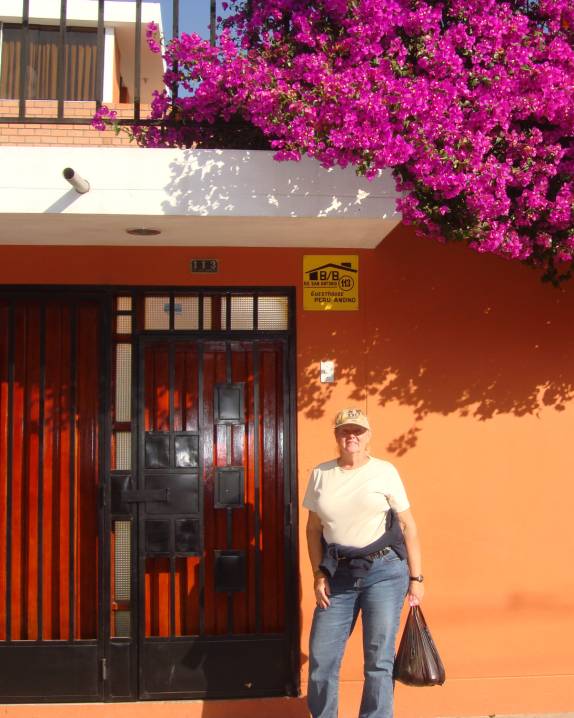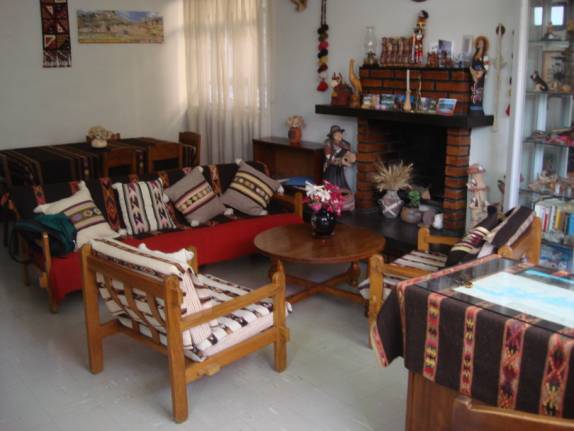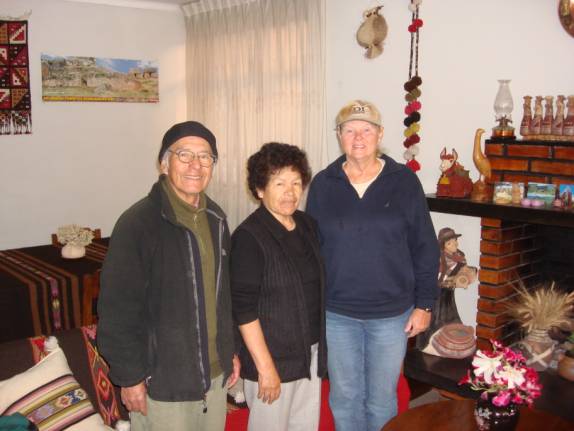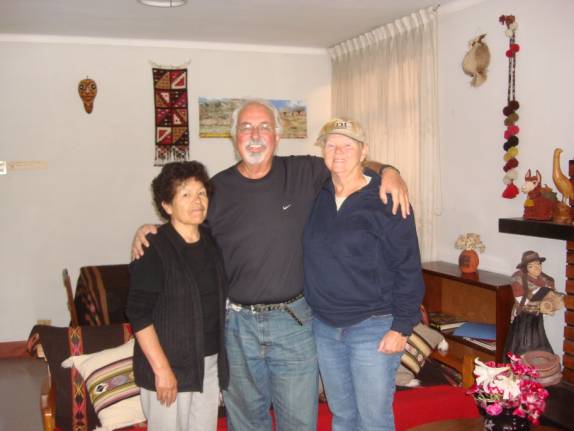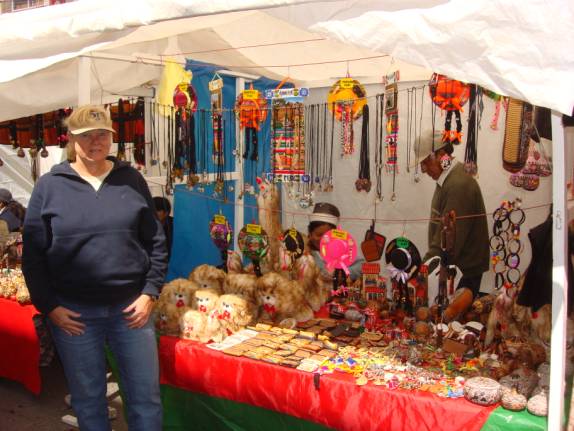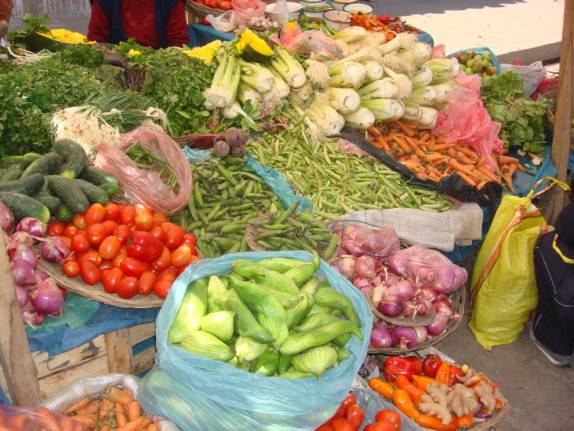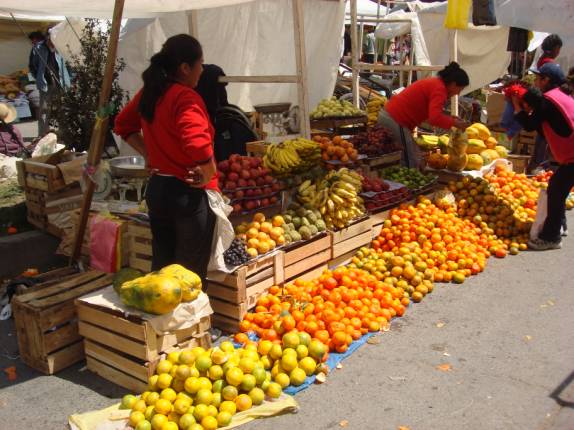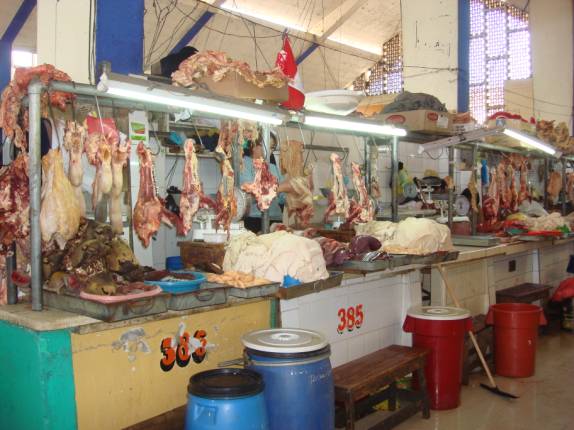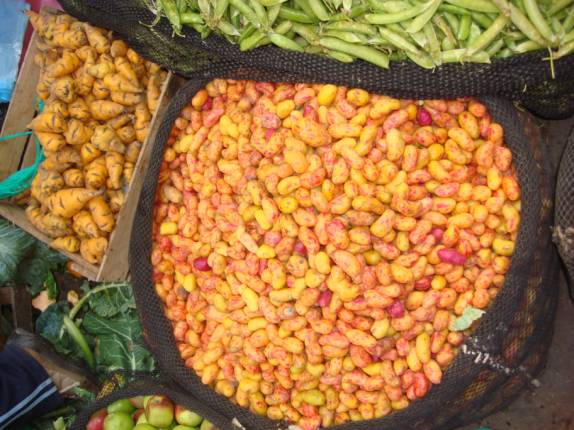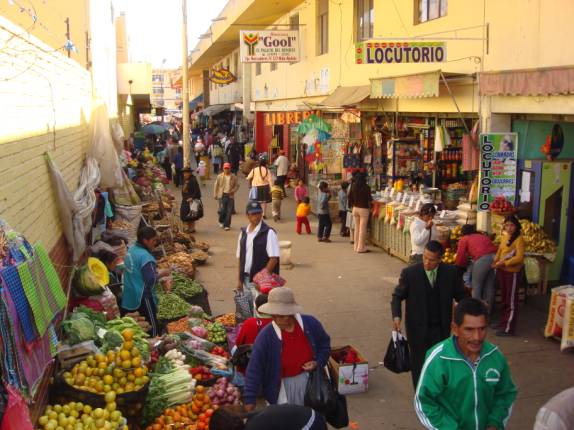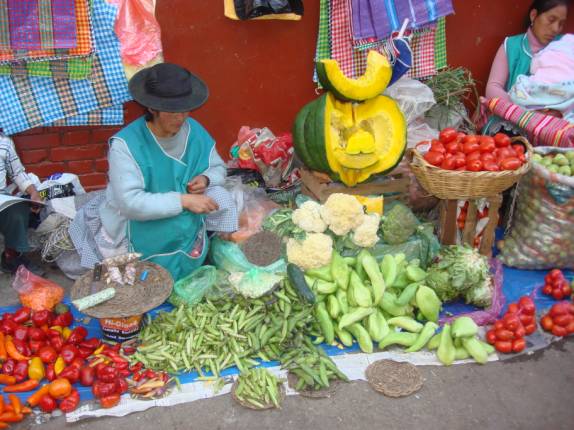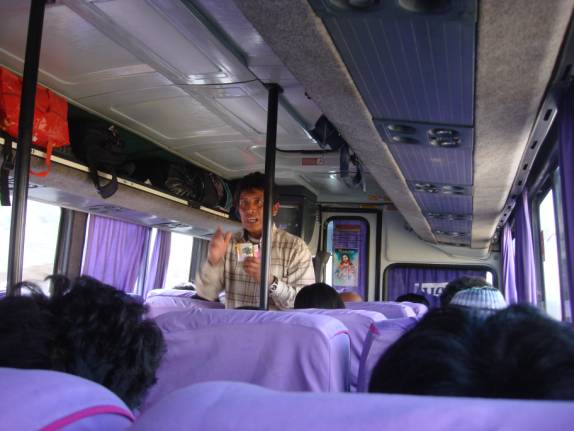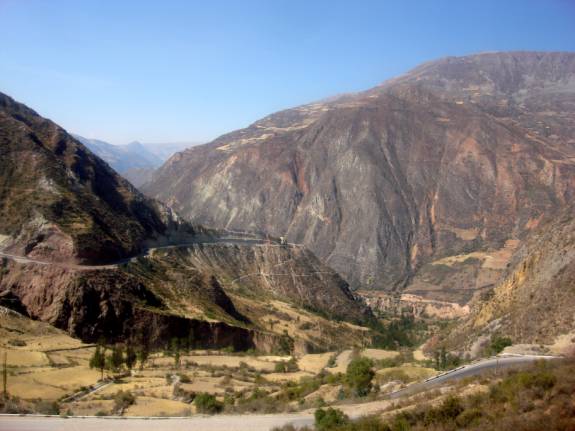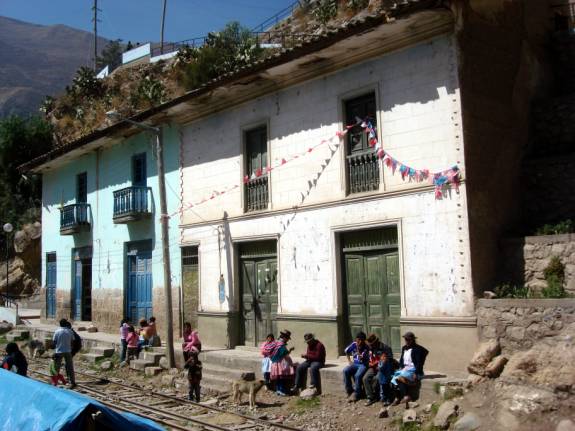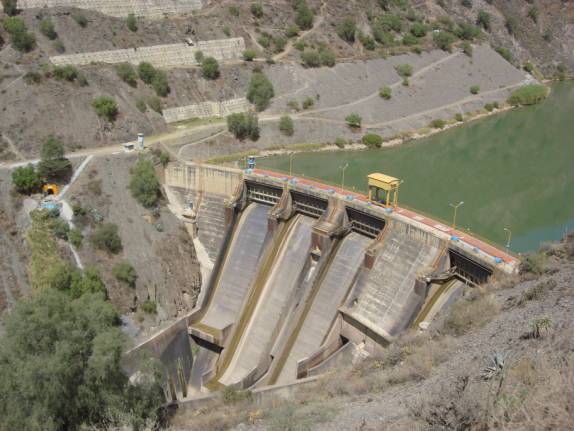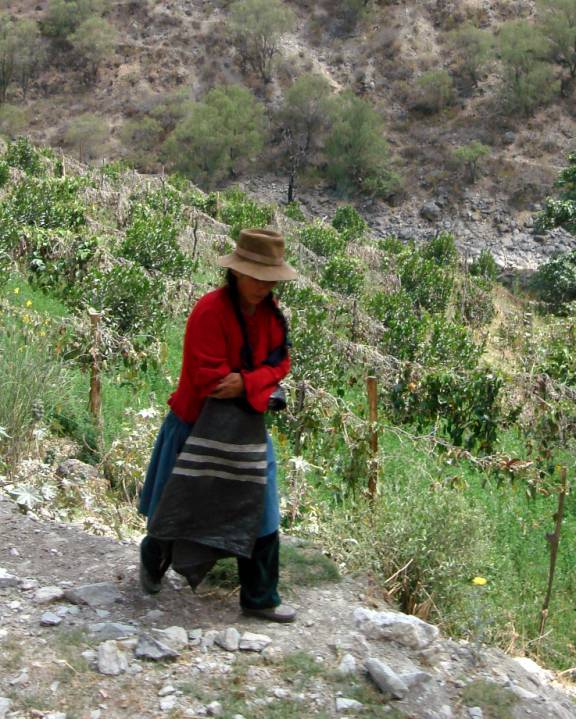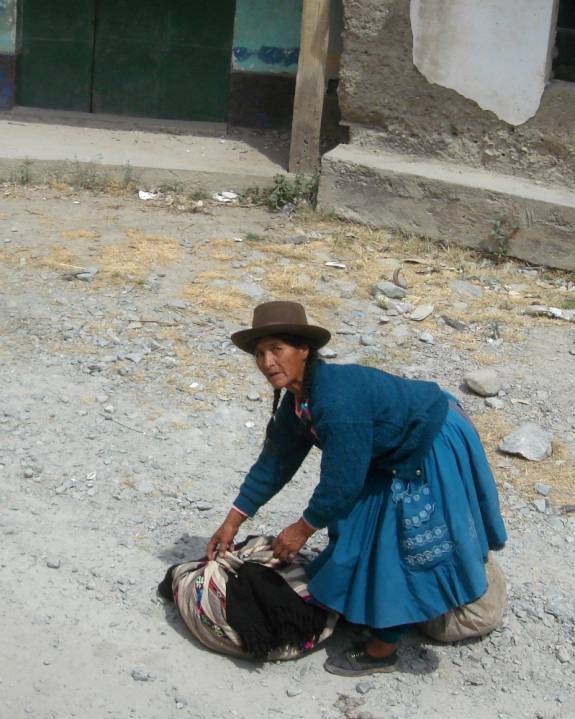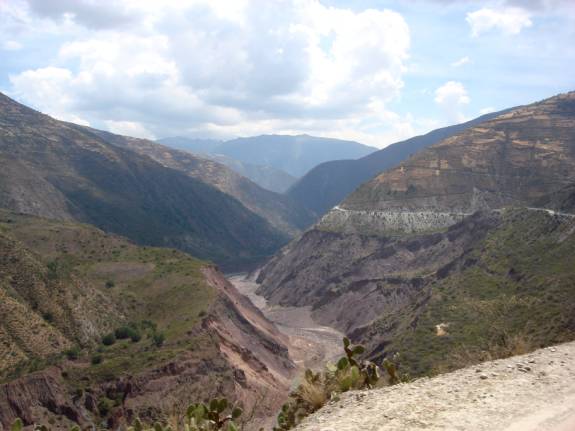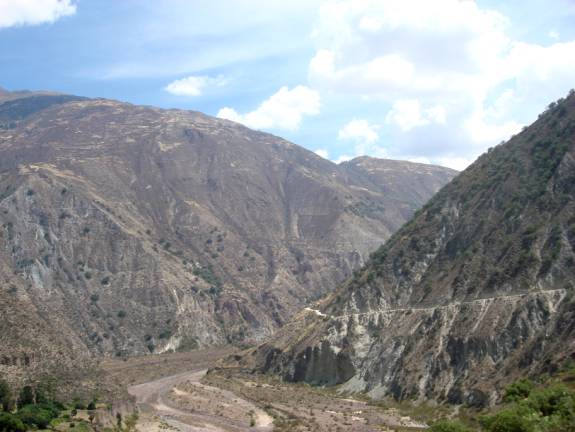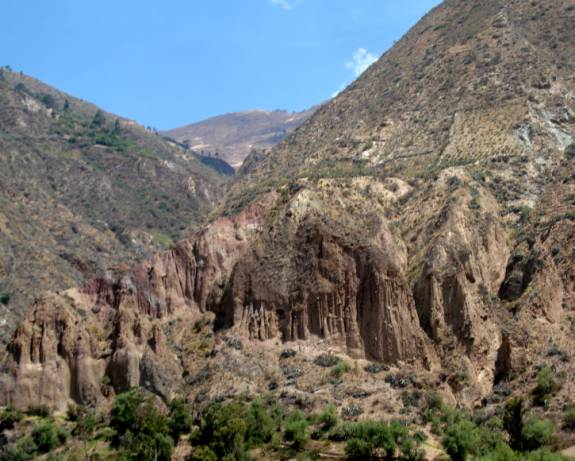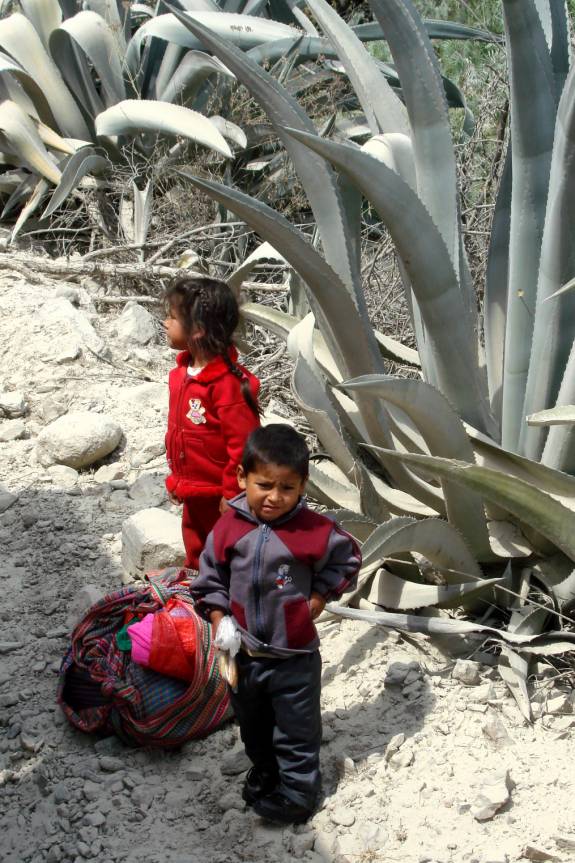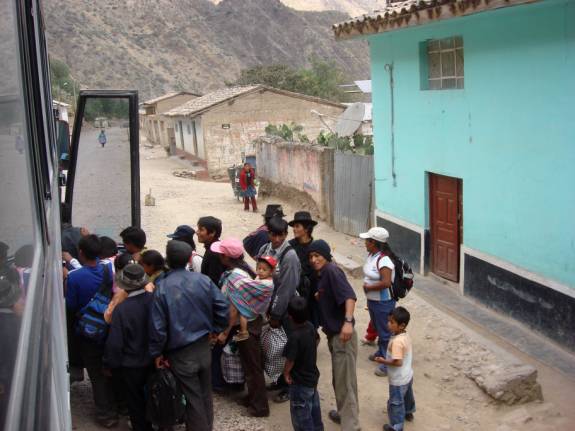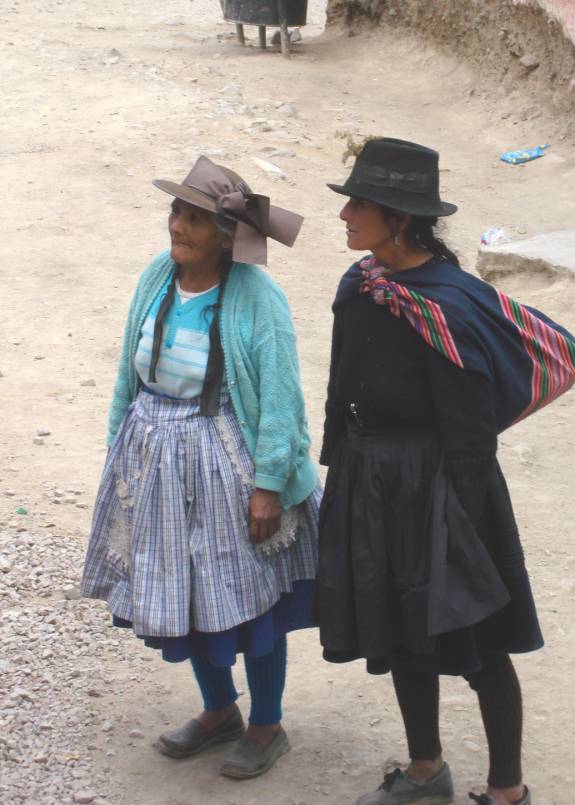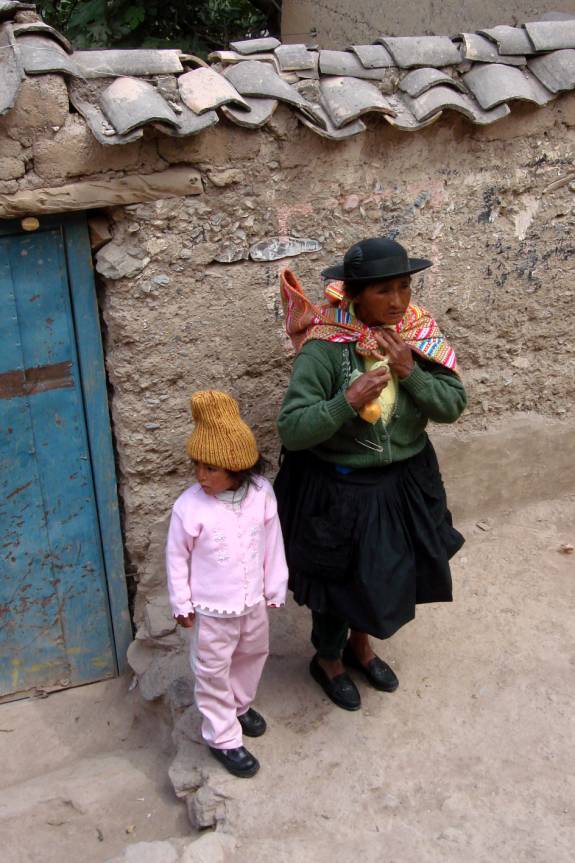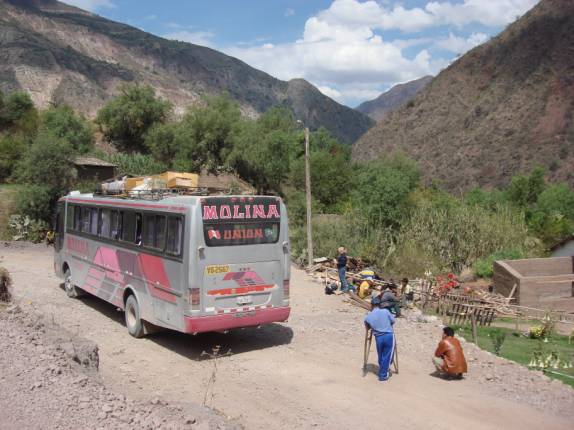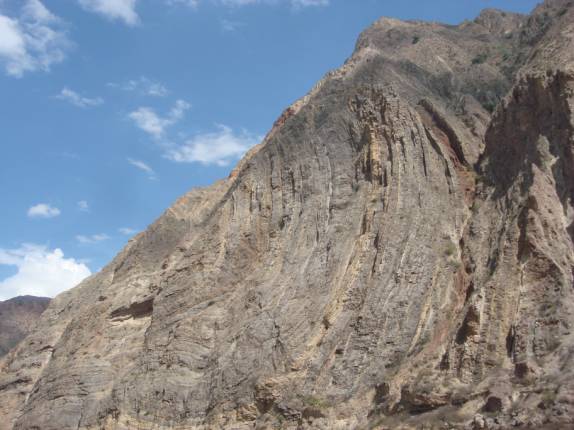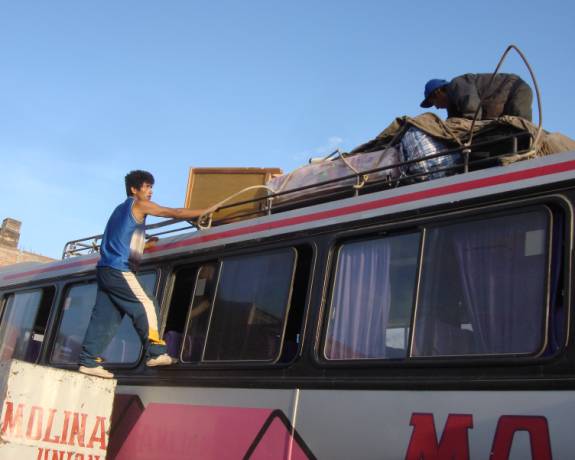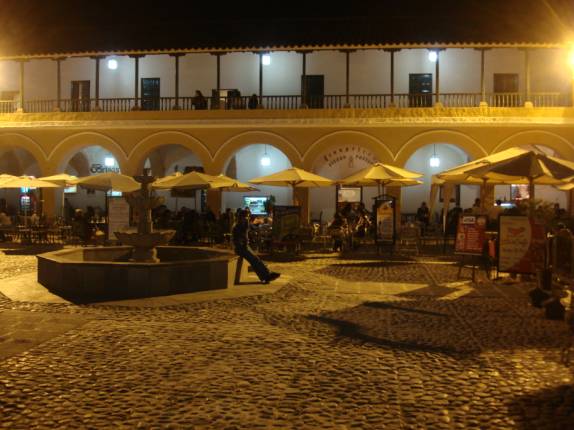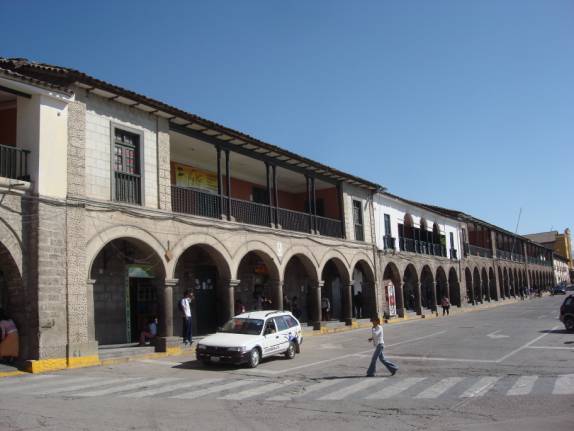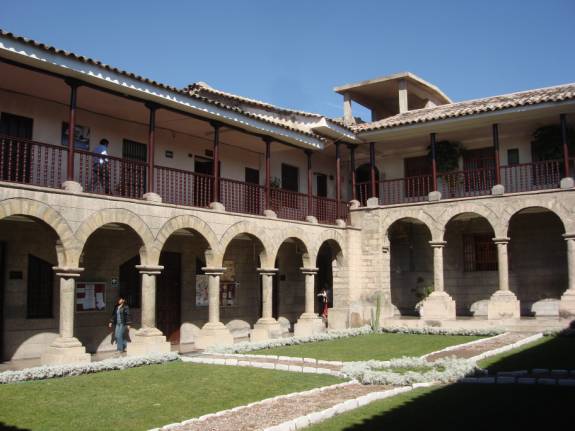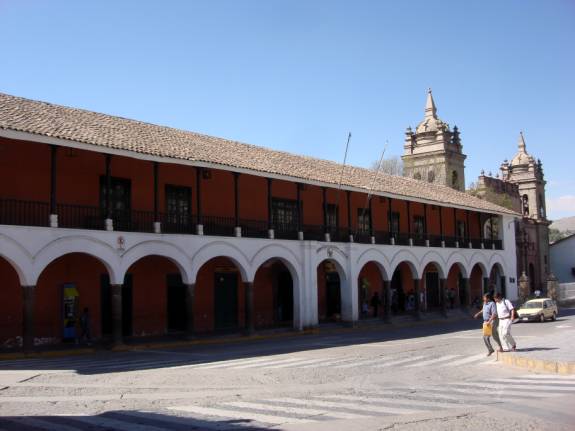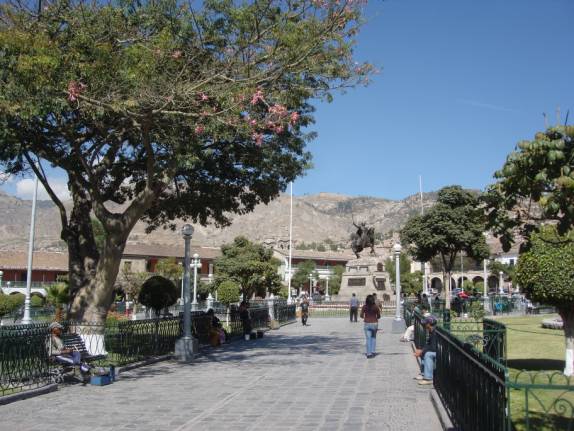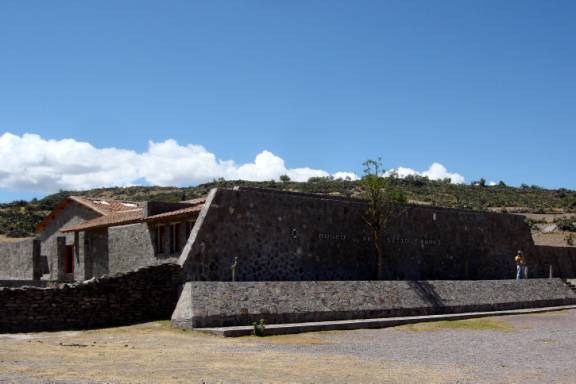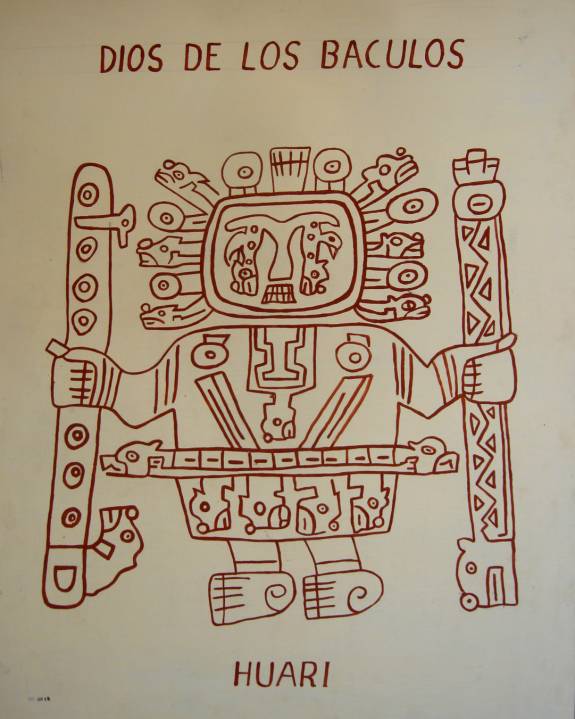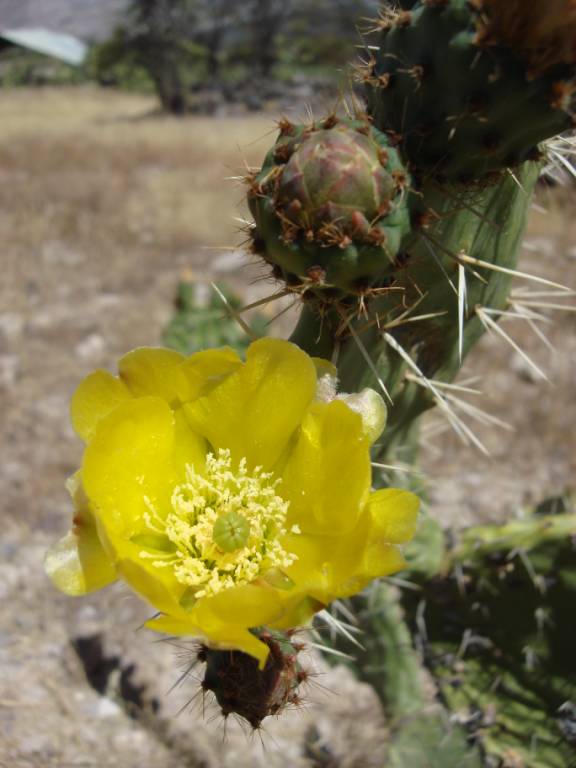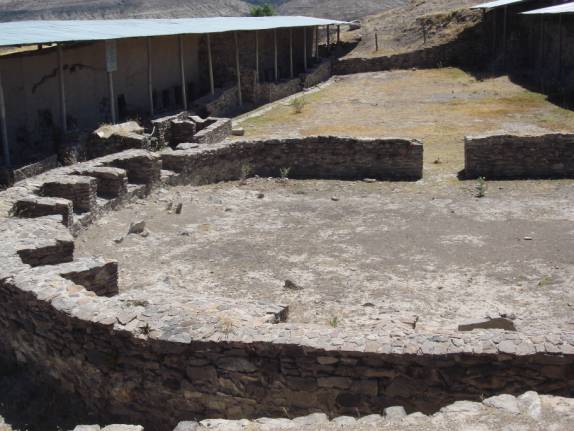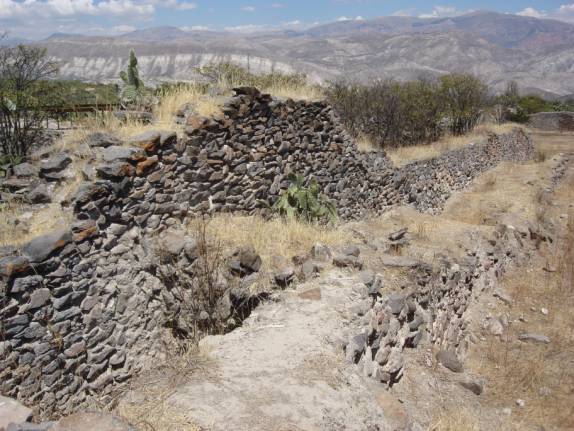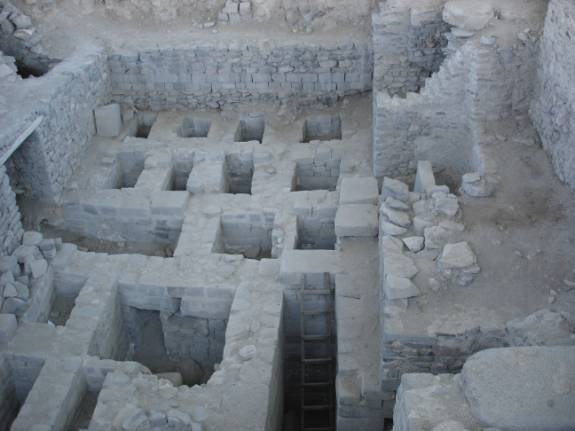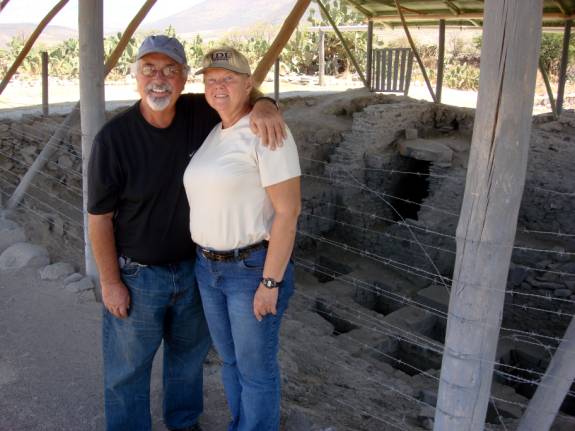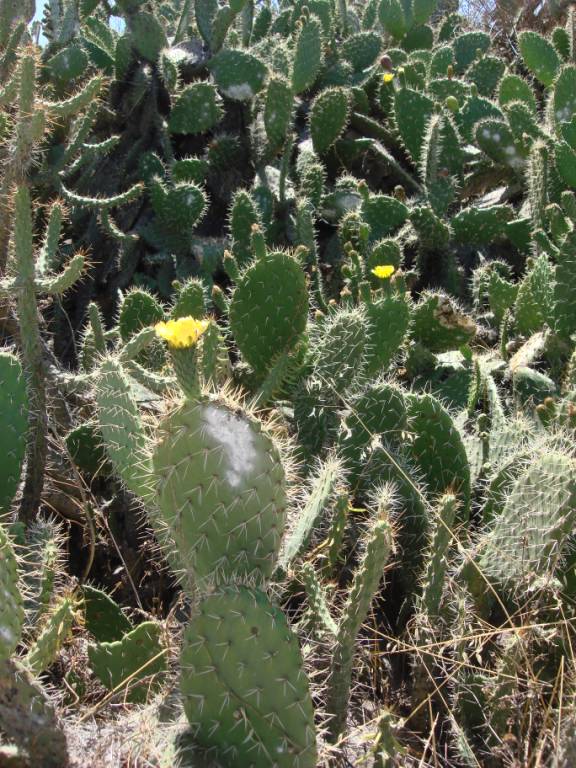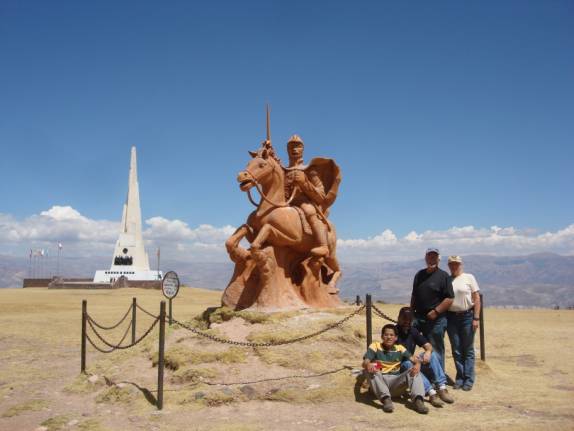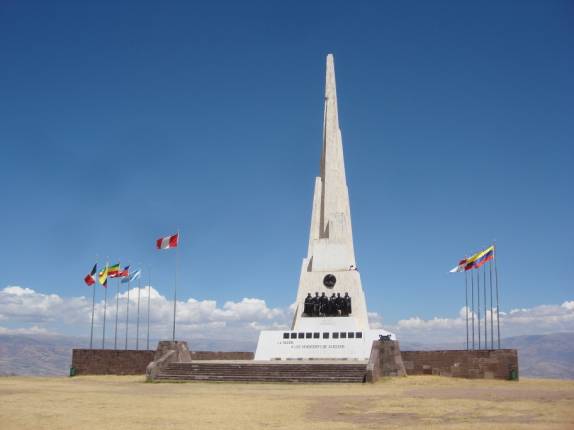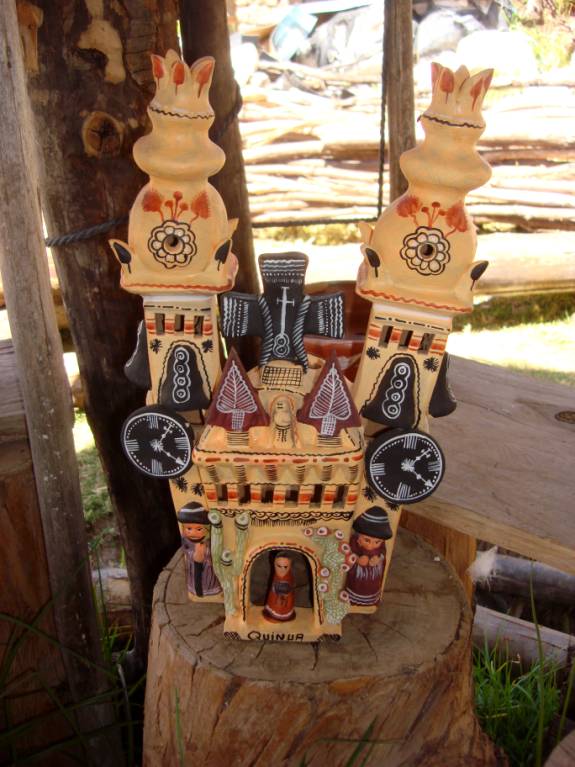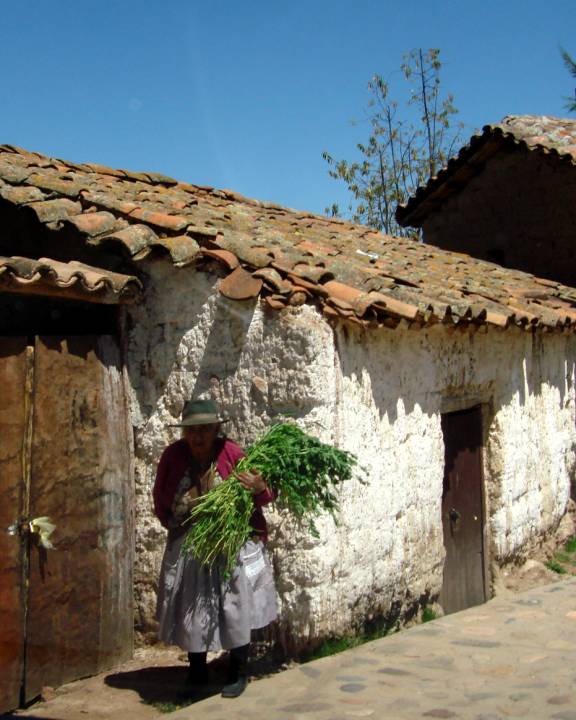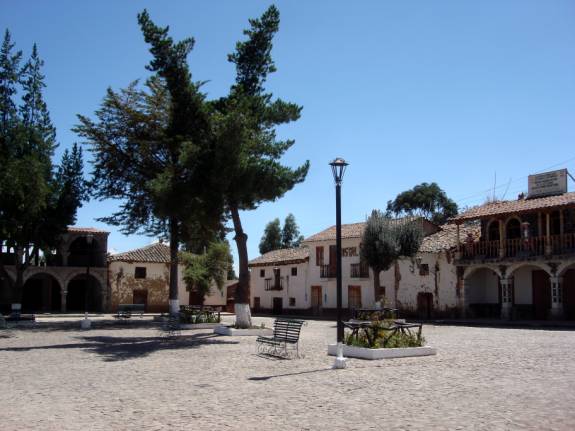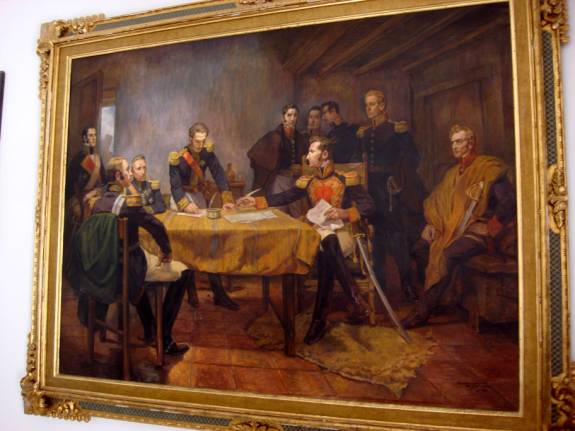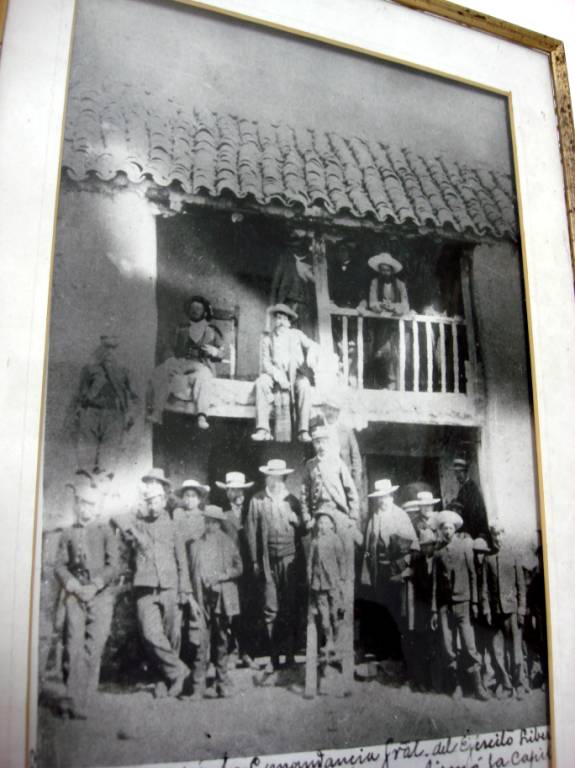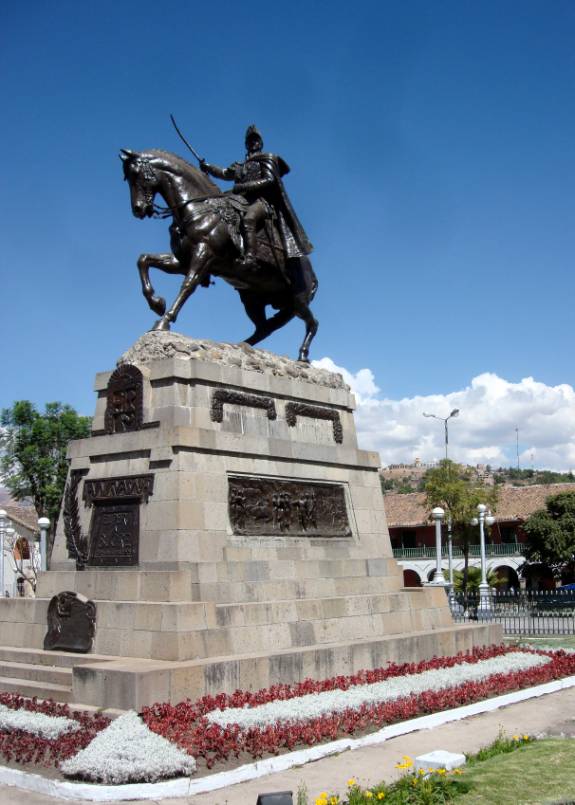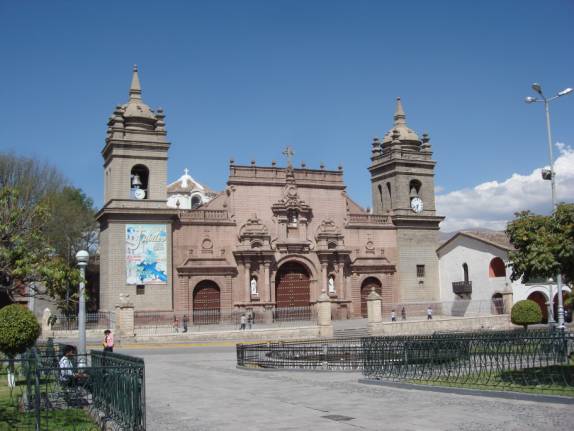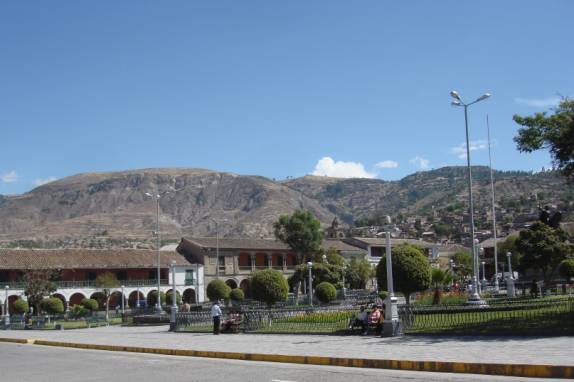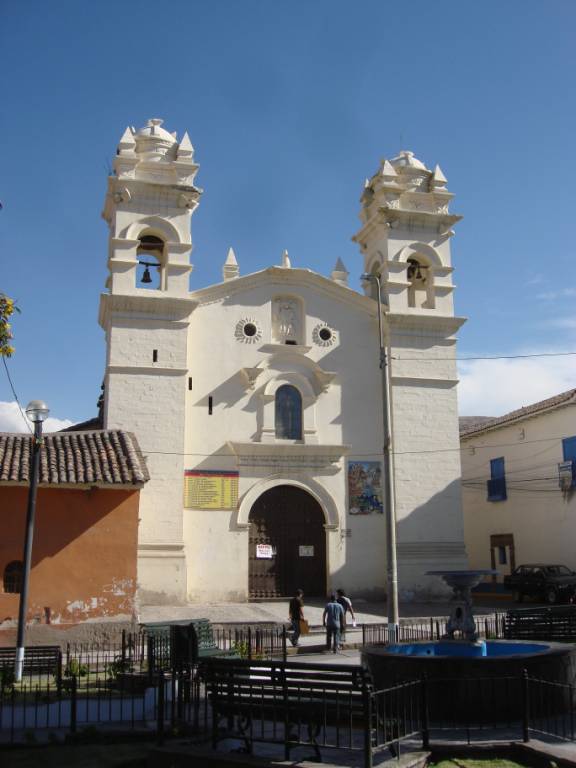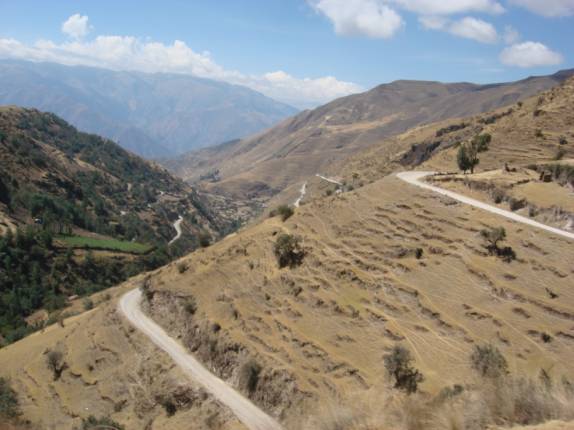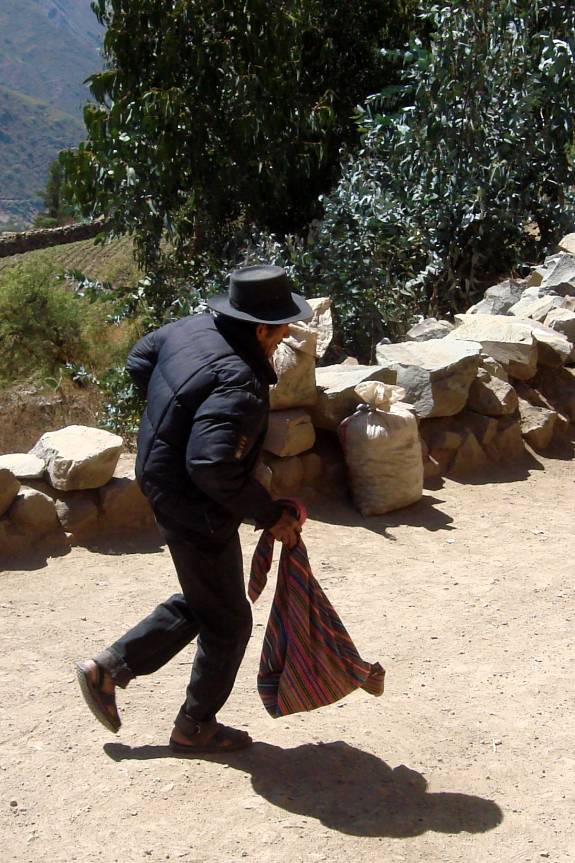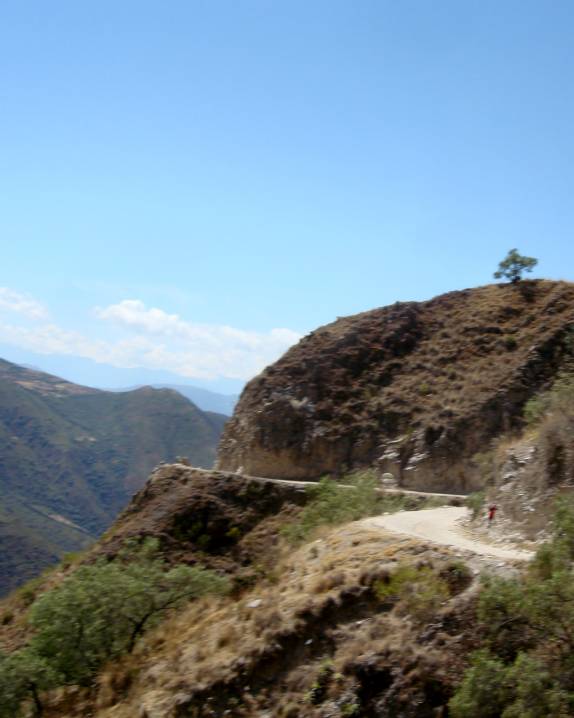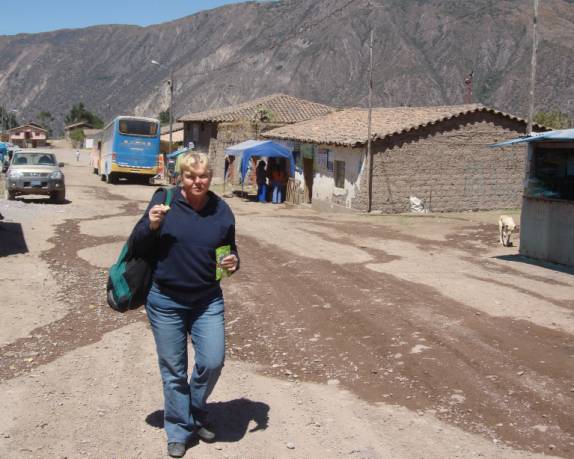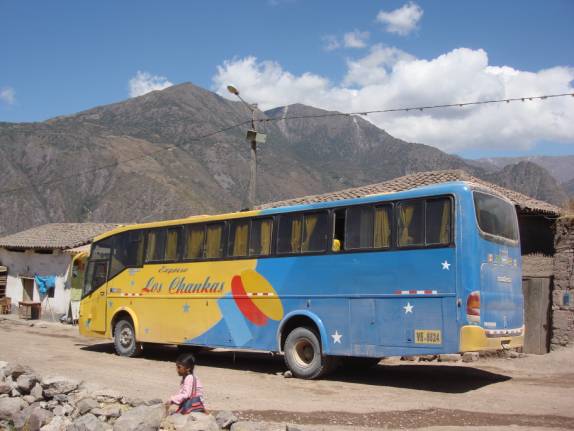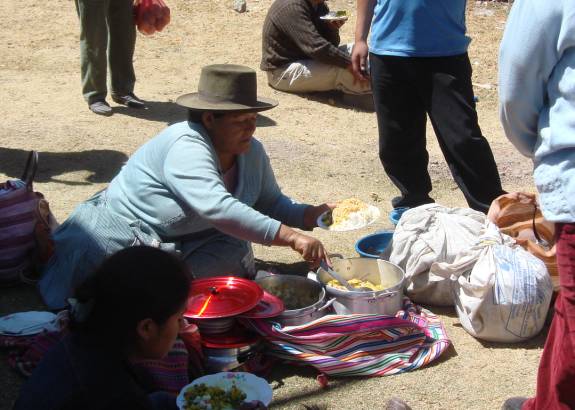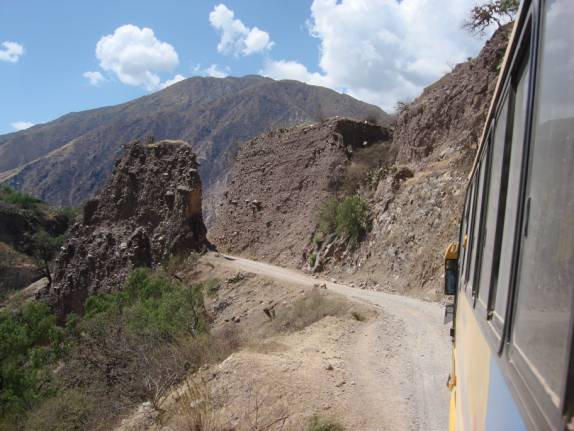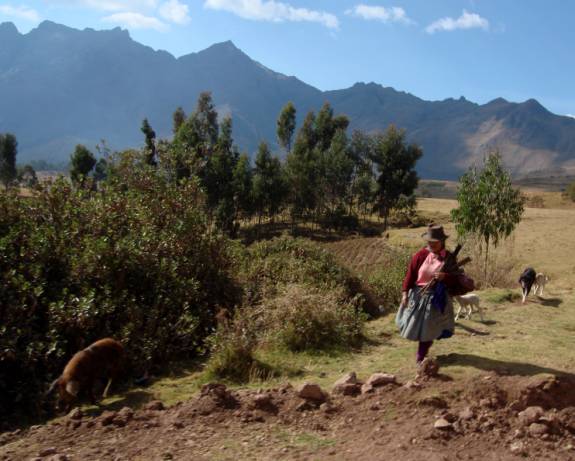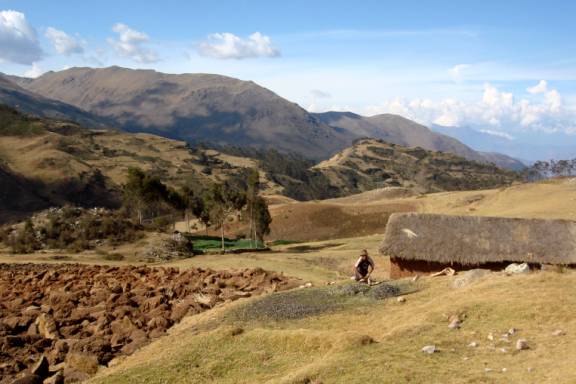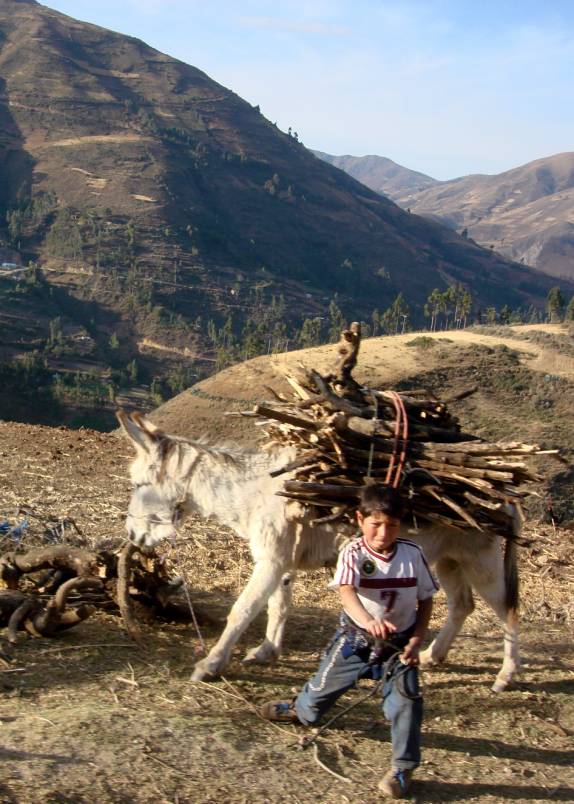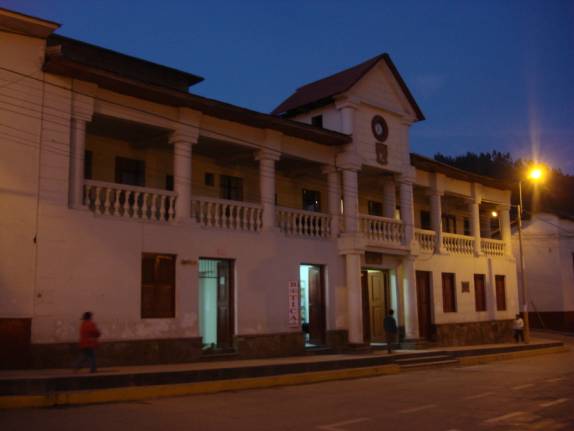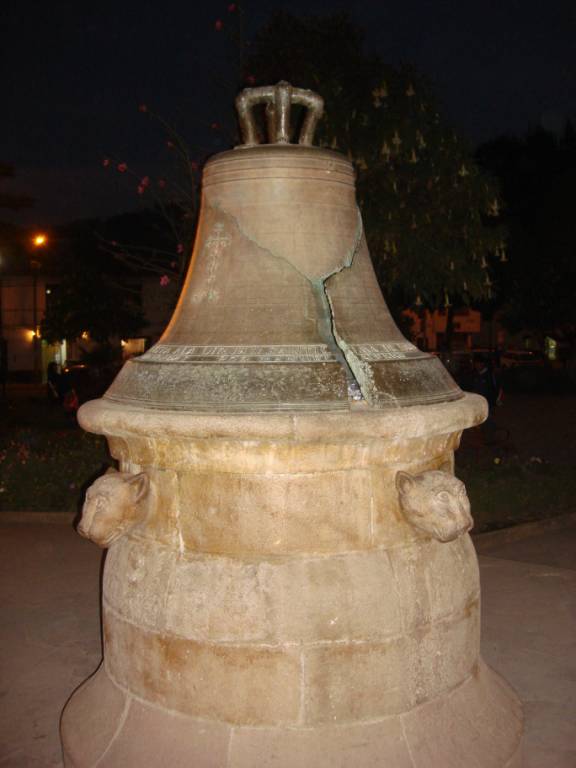|
|
|
|
Site Index:
|
UPDATE#18
08/17
thru 08/20/08
Howdy
Everybody, The
adventures of 2008 from 1/1/08 through 08/16/08 have been published on the
website.
We continue with the latest edition. UPDATE
2008 #18
08/17/08 through 08/20/08. At
last update, we were enjoying our adventure trip to the South American country
of Peru and a several day visit to the central highland city of Huancayo. 08/17/08
SUNDAY
HUANCAYO
Our stay at the Hostal Peru Andino, located at Pasaje San Antonio, #113
in Huancayo, has been peaceful and nice.
Set on a tranquil side street, away from the hustle and bustle of the
main square and business zones, the residential neighborhood is perfect for
resting up and sleeping soundly.
To get to the center of activity, you can either walk for about 15 to 20
minutes, or you can hail a taxi for the low price of less than one dollar.
The sitting area is clean and comfortable.
Our congenial hosts and owners, Luis and Juana, went out of their way to
make our stay comfortable and pleasant.
Juana, Fred, and Judy…
The most interesting place to be on a Sunday in Huancayo is the “Feria
Dominical” (Sunday Fair).
Street after street is closed off to vehicle traffic.
Every available space is lined with hundreds, maybe thousands, of vendor
booths.
Just about anything you could imagine is for sale somewhere in this huge
maze of merchandise.
If you were hungry for some “Cuy” (pronounced “Kwee”), you could
find plenty of them here.
Guinea pig is one of the top favorite dishes in Peru.
In North America, these cute, little furry creatures are called
“pets”; down here in Peru, they are called “yummy dinner”.
Just about any fresh vegetable that you could think of can be found
heaped in a pile somewhere around the “Feria” or “Mercado”.
A large array of fresh fruits are picked ripe and juicy delicious.
Prices are economical too.
Nearby, the daily indoor market is also in full swing.
Be aware that the cuts of meat may be significantly different than what
you may find at your Wal-Mart superstore.
The huge white mounds are piles of thinly sliced stomach linings (Tripas).
How about a huge hunk of "Lengua" (Tongue)?
Care for a nice thick slice of “Higado” (Liver)?
Maybe you’re more interested in that piece of "jaw bone" with the teeth still
in it?
What’s that you say?
Oh, I’m sorry; I forgot that you're recently become a
"Vegetarian".
Hens and chickens are often displayed with the internal organs still
attached.
It is easy for the astute shopper to see how fresh the meat is by the moist
condition of the organs.
I haven’t quite figured out this colorful display yet.
It was definitely unusual and unique.
We didn’t see any others like these.
What did they do here?
Most of the time, the fish appeared to be very fresh.
You could get your choice of filets, steaks, or Pescado Entero (whole
fish).
These colorful gems look just like potatoes.
Not knowing any better, I thought that these would taste excellent if
just parboiled and then sautéed in a little butter.
Thinking that they would be a colorful hit, I bought about 3 pounds with
hopes that our host, Senora Juana, would help me cook them up.
When I asked her, she promptly informed us that these were not potatoes;
they were “Ocas”.
I was further informed that it would not be possible to cook them my way.
These must be prepared according to a special, time-consuming process
much different than my simple idea.
Realizing that it just wasn’t going to happen my way, I made a gift of
these “Oca” for a later meal for Luis and Juana.
Miscellaneous vendors line the streets, featuring a wide array and
endless variety of goods.
The red peppers are “Rocoto” and have a hot, spicy flavor.
They are frequently prepared as “Rocoto Relleno” (spicy stuffed
peppers filled with rice and meat).
During this weekend, a major change has taken place in this city.
The accepted way of life and the established shopping habits that have
existed for centuries will be altered forever.
On Friday, a huge store opened up for business.
Called “Plaza Vea”, this gigantic chain store resembles a Wal-Mart
Hyper mart.
Modern marketing of grocery products, appliances, household goods, and
typically related items will now be available to the general populace in a way
they’ve never known before.
We walked through the humongous, totally mobbed store that was filled to
overflowing with eagerly shopping families.
“The times, my friends, the times they are a changing”! 08/18/08
MONDAY
HUANCAYO to AYACUCHO
A 6am alarm had us ready for breakfast a half hour later.
Luis and Juana had everything laid out and ready.
A taxi took us to the company terminal for Transportes Expreso Molina.
Our 7:30am bus was very late this morning.
With our luggage lashed on the top racks, the bus for Ayacucho departed
at 8:20am.
Our choice seat numbers, 23 and 24, provided the best views from the recommended
right side of the bus.
As soon as we were underway, this fellow gave us all a welcome message
and some information about the trip (in Spanish, of course).
I initially thought he was the conductor of the bus, however, he soon
began his fervent spiel about various medical problems that could possibly
affect the human body.
In the true fashion of a “snake oil salesman”, he slithered into his
remedies for these various illnesses.
There was a medicine for the liver, another for the prostrate, and yet
another to cure the unthinkable problem of impotence.
Fortunately, I didn’t have any overt symptoms of these horrible
maladies.
To negotiate the rapidly changing terrain and elevation, the roadway
winds, climbs, and continuously wraps its way through the passes of the Andes
Mountains.
In the important village of Izcuchaca, one of the few bridges in the
Mantero Valley permits crossing of the river.
Legend has it that this ancient stone bridge was built by the Incas and
was defended by Huascar against the advance of Atahualpa’s troops during the
civil war that was raging in the Inca empire when the Spanish arrived in 1532.
From Huancayo, the main rail line runs through Izcuchaca on its route to
Huancavelica.
With the temporary shutdown of the tracks for rail changes, the village is largely
isolated from their main means of conveyance.
This dam creates a major source of hydroelectric power for the villages
along the Mantero Valley.
The indigenous people of these remote Andean villages provide an
interesting accent to the rugged landscape.
…A river runs through it…
The roadway runs along the steep embankments.
At each village, a group of people gets off the bus; another bunch
eagerly clambers to fill their tightly packed vacancies.
Sure, there’s always room for a couple more…
The fully loaded bus makes infrequent stops for the ‘Bano’ (toilet)
and for the occasional lunch.
At 4:45pm, the boys scampered atop the bus to retrieve our bags.
The driver had managed to make up some time, as we were only 15 minutes
late to Ayacucho.
We took a taxi to the Hotel Yanez for check-in.
Our first order of business was to locate a tour operator.
The only tours available for tomorrow were to Wari and Quinua.
We selected Urpillay Tours at their office under a portico near the main
plaza.
After locating the company terminal for Expreso Los Chankas, we purchased
our tickets for Wednesday’s trip to Andahuaylas.
We also purchased advance tickets for Thursday’s continuation to Cusco
by bus.
In the beautifully remodeled courtyard of an old Colonial mansion, we
found a café restaurant for dinner.
The food was not particularly good or otherwise remarkable.
Even though there are very few tourists in this part of Peru, it was
unfortunate that this particular spot seemed to attract altogether too many
cigarette smokers.
Back at the Hotel Yanez, the staff and guests were very noisy.
Although officially closed, the sounds emanating from the restaurant area
seemed to echo through the paper-thin walls.
I don’t know if it was mind over matter or just plain exhaustion that
allowed us to drift off to sleep. 08/19/08
TUESDAY
AYACUCHO
Although we could have slept a little later, the noise began around the
hotel about 6:15am.
I ran the faucets for quite a while hoping for the illusive hot water.
Perhaps not as cold as at the start, my morning shower was only
marginally above "frigid" at the end.
It was just slightly warmer for Judy’s turn.
By 8:15am, we were out to see the town.
Ayacucho has retained its colonial atmosphere more than most Peruvian
cities, and colonial buildings and churches dominate the central district.
The Iglesia de San Augustin is located along the northern pedestrian
walkway near the main plaza area.
The perimeter of the main Plaza de Armas is lined with colonial styled
buildings with arched porticos.
This is Portal Constitucion; the others are Portal Union, Portal
Municipal, and Portal Independencia.
Focused in the center of the Plaza de Armas, an enormous bronze statue
commemorates Peru’s most famous liberator, General Antonio Jose de Sucre.
…Portal Union…
Many of the colonial mansions have been converted to municipal offices.
We can only wonder about their early elegance.
Portal Municipal shares this block with the Cathedral.
Our 9:30am tour finally departed at 10am.
The tour van carried us, along with two Peruvians and our guide, Carlos,
to the site of the Wari ruins.
The Wari Culture developed
in the present Ayacucho Region around 500 AD. With influences from the coastal
areas of the Tiahuanaco and Nazca, the Wari are credited with the construction
of a number of pre-planned cities, thus originating the first Andean empire.
The Wari, or “Huari”, as they are sometime referred, controlled a
wide territory and their culture was actually the precedent from which the organization of
the Inca Empire was based. Its capital, in the Ayacucho Region, was the
“Citadel of Wari”.
An elaborate system to carry and manage the water supply was created at
the Citadel.
The strange shape of this skull was formed intentionally.
By tightly binding the head while a child was still in infancy, the soft
bone structure became elongated and distorted.
As a sign of special significance, persons with this head shape were
shown special treatment and advantage.
Ancient skulls also showed indications that skull surgery, or
experimentation, had some historical reference.
The Wari held the Sun God, “Wiracocha”, as their highest deity.
This representation shows strong indications of snakes and pumas as
resident parts of the Sun God.
In gorgeous yellow bloom, large stands of pear cactus flourish in the
high desert climate.
Within the grounds of the Citadel, this traditionally sacred altar area
bears the distinguished signs of classic Wari design.
A largely circular form, with numerous niches and a gate port along the
two flat sides, typifies the Wari origins.
Surrounding the altar area, additional niches were constructed for the
offerings of food, trinkets, and valuables from believers to their Sun God.
Only the elite priesthood would be allowed admittance in these sacred
areas.
Great double walls that ranged between 8 and 12 meters in height form the
Capilla Pata section. They are some 400 meters long, 3 m wide at the base and
0.8 to 1.2 m wide at the top, and form great walled-in areas, known as "canchones".
Cheqo Wasi featured the
presence of multiple, finely finished rectangular stone chambers, probably
burial vaults, of different sizes.
In those times, bodies were interred in the sitting, infantile position.
The Wari complex remains, for the most part, underground. The areas
excavated at this site are minimal when compared to the size of the total
built-up area that once comprised almost 18 square kilometers.
Initially, the site may have only performed administrative functions of a
political and religious nature.
As its population increased, the city also grew in importance as a center
of political power.
According to archaeological evidence, Wari lost its importance around
1000 AD, and nobody knows how or why it was eventually abandoned.
The father and son, Fernando and Carlos, came here from the northern
coastal city of Trujillo, Peru.
With a keen interest in Peruvian national history, they were interesting
companions for our tour.
Having some knowledge of English, they kindly helped with the translation
of some key facts about the Wari history.
Our tour progressed to the important battlefield on the “Pampa de
Quinua” that resulted in Peru being liberated from Spanish rule.
The
Battle of Ayacucho was the last major encounter of the South American war for
independence. Fought on December 9th, 1824, the engagement resulted in a
decisive victory for the South American rebel forces under the leadership of
General Antonio Jose de Sucre from Venezuela.
After General Sucre and Simon Bolivar defeated a Spanish force at Junin
in the central highlands of Peru in August 1824, General Jose de La Serna, the
Viceroy of Peru, marched a Spanish army against the rebels.
Arriving from Cuzco, this Spanish contingent boasted a well-disciplined
and superior army of 10,000 men and 1,600 cavalry.
General Sucre, with only 6000 Peruvians and Colombians under his command,
initially tried to avoid battle but finally made a stand at Ayacucho early in
December. Sucre attacked the Spanish royalist army while it was attempting to
force its way down from the surrounding hills to engage them.
With the advantage of position on the high plain, Sucre wisely
capitalized on La Serna’s tactical error of being hampered in restrictive
terrain.
La Serna was unable to get his troops organized for the advance.
After an unsuccessful attempt to outflank the rebels, the Spaniards were
quickly overcome.
La Serna was wounded and taken prisoner. The
Spanish Royalist army suffered 2,000 dead and wounded, lost 3,000 prisoners, and
the remainder of the army became entirely dispersed.
The
Battle of Ayacucho resulted in the Spanish surrender and marked the end of
Spanish power on the continent of South America.
A huge monument, called the “ Altar de Los Libertadores Americanos”,
is a tribute to the “Vencadores”.
It is dedicated to “those who came” to enable the liberation of Peru,
and all of South America, from Spanish rule. The
44-metre
(144 ft) obelisk symbolically commemorates the 44-year struggle for
independence.
In Quinua, a village located 40 km from Ayacucho, pottery is the town's
main activity. The qualities of the local red and cream-colored clays lend these
works a unique characteristic. Despite their simple, almost childish forms, they
are highly expressive. Quinua is best known for ceramic pieces such as small
churches, chapels, houses and bulls called the "Toro de Quinua". Local
potters have also become popular for figures such as peasant farmers, gossiping
neighbors and a variety of religious themes.
The roofs of most buildings, including the church in the center of Quinua,
display miniature cathedrals made of local pottery.
The town was mostly vacant on the day of our visit.
Viceroy José de la Serna signed the final capitulation of the Royalist
army. Many
aspects of history have been perceptually altered by inaccurate reports and
events portrayed by “artist conception.”
In this painting, the artist gives his version of the signing by La
Serna.
In actuality, the setting was significantly different.
This is reportedly a photograph of the place and attendees to the
signing.
There appears to be many different interpretations here.
Located in a small room of a little museum in Quinua, this stone table is
said to be the one used to record the signing and surrender of Spanish army by
Viceroy La Serna.
With the tour route completed, we had returned to central Ayacucho by
early afternoon.
Along with some local sightseeing of the Mercado de Abastos (main Market)
and the Mercado Artesanal (craft market), we took a ride in the type of MotoTaxi
most commonly used in this city.
The city was originally born and named by the Spanish Governor of Peru,
Francisco Pizarro, in 1539 as “San Juan de la Frontera de Huamanga”.
Following the defeat of the Spanish Army by General Sucre in 1824, the
city was renamed, per mandate of Simon Bolivar, as “Ayacucho” in honor of
the battle.
In the Quechua language, the name means, “the death ones' corner”.
The Basilica Cathedral shares the block with Portal Municipal in the
heart of Ayacucho.
Parishioners are already celebrating “Jubileo”, the 400-year
anniversary occurring in 2009.
Ayacucho is sometimes called “the city of churches”.
It is claimed to have 33 churches, one for each year of Christ’s life.
Late in the afternoon, we visited this church, Templo Y Monastario de
Santa Teresa.
Interestingly, the guide, Carlos, from our earlier tour, was leading a
local city tour and showed us how to get inside the chapel.
This decorative arch stands at the southern foot of the “Calle Peatonal”
(pedestrian street).
Today, the pedometer registered 8.58 miles of walking. 08/20/08
WEDNESDAY
AYACUCHO to ANDAHUAYLAS HAPPY BIRTHDAY to MARK LAW
(Judy’s oldest son)
All three alarms may have sounded at 5:30am, however, neither Judy nor I
heard them.
For some unknown reason, perhaps subconscious, I looked at my watch at
5:33am.
We jumped right up and were walking out of the Hotel Yanez by 6am.
The 6:30 am Expreso Los Chankas bus left their station just 18 minutes
late.
When I purchased the tickets a couple of days ago, I inadvertently failed
to check the seat assignments to match what we requested.
Unfortunately, the requested ideal seats #23 and #24 were mistakenly
entered as #33 and #34.
This error placed us in the very rear seats of the bus resulting in a
very rough and uncomfortable ride along the gravel roadway.
The trip was very long, very dusty, very crowded, very hot, and very
bumpy in our “back of da bus” seats.
I must admit, the magnificent, mountain scenery more than rewarded us for
all the discomfort.
Given the adventure and experience we had, I would gladly do it all
again.
Hairpin turns, struggling to hug the precipitous drop-offs, were common
along the narrow, sinuous route.
Some of the villages in the central highlands attempt to keep the dust
down by spreading water on the road.
Of course, we were the only Non-Peruvian travelers in the whole area.
You might say, “…youz guyz were definitely ‘off-the-beaten path’
on this adventuresome trip”.
The lunch choices were between a dirty, nasty little restaurant and
several street vendors offering local, homemade fare dished up from various
pots. We
chose to nibble on chips, bananas, and to sip our bottled water.
A rather scratchy sounding CD player belted out traditional Central Andes
music.
The high-pitched voices and distinctive tunes sounded somewhat Asian.
It would be difficult for me to develop any real appreciation for this
music style.
The native people of the Andes Mountain regions are very fascinating.
Their rural lifestyle is so drastically different from our way of life.
After 10 and a half grueling hours seated in the most uncomfortable seats
on the bus, we arrived in the city of Andahuaylas.
The bus parked at the “Terminal Terreste” (central bus terminal).
We had expected to arrive at the center of town as was indicated in our
guidebook.
Hailing a MotoTaxi, we tossed our bags aboard and zipped off to the
“Hotel Sol de Oro”.
Although we didn’t have a reservation, we had made a good choice, as
the place was clean and comfortable.
In Inca times, the Condor or "Apu Kuntur" was considered a very
special divinity that joined the "Hanan Pacha" (Sky spirit) with the
"Kay Pacha" (Earth spirit).
In some
remote villages, the Inca descendents celebrate what is known as " Yawar
Fiesta", or "Blood Celebration", starting with the capture of a
live Condor.
Performing various ceremonies in its honor, it will be very adorned and
native people will offer it wine or rum to drink; the Condor will begin to get
drunk after a while.
A bullring-type arena is prepared in the village's main square for all
the population to attend. In the spectacle, the feet of the Condor are either
lashed or sewn onto the loin of a bull and, then, the two animals are turned out
into the open ring. With its feet bound, the drunken condor violently attempts
to recover its freedom. The Condor uses its powerful beak to tear into the
bull's back and rip its flesh. The bull retaliates by undertaking a wild, angry
struggle to get rid of the Condor. The bull will not surrender and ends up
losing a massive amount of blood.
Before the severely injured bull fully collapses, the leaders will stop
the spectacle; the animals will be separated and the death of the bull will not
be allowed.
To the indigenous people, the Condor is the
connection between the “sky” and the “earth”. Having just eaten fresh
blood and meat, they believe it will remain satisfied for the coming year. The
following day, the peasants have another ceremony to release the condor in
unconditional freedom.
The annual "Yawar Fiesta" is not only a
celebration to honor the "Apu Kuntur" but also as a form of
"revenge" that the native Andean people, represented by the Condor,
have against the humiliating conquest and Hispanic repression, represented by
the bull that was imported from Spain.
This interesting statue, in the Andean city of Andahuaylas, represents that
ritualistic celebration.
We did not have much of an opportunity to explore this remote city.
We walked to the main plaza and around the central business area.
Not finding a lot of interesting choices in town, we decided to dine at
the hotel restaurant.
I am happy to report that it was very good.
Our trip today had left us virtually exhausted.
Fortunately, we rested well in our quiet hotel. TO
BE CONTINUED…SOON…
Please let us know if you have any special suggestions and thoughts. Fred
Reed and Judy Law AMARSE MT40 "AMARSE". is pronounced "AM-ARE-SAY".
Our website is: www.amarse.net .
|
|
Fred H. Reed |
www.amarse.net © 2006 2007 2008 2009 2010 2011 |

